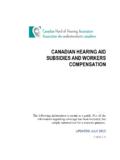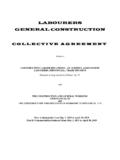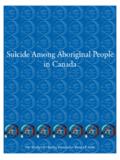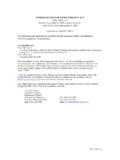Transcription of Large variations in health care use across provinces …
1 1 Large variations in health care use across provinces and territories in canada raise questions about the efficiency and equity of health service delivery A new OECD report (based on data from the Canadian Institute for health Information) shows that there remained Large variations in hospital medical admission rates and in diagnostic and surgical activity rates not only across provinces and territories , but also across health regions within different provinces in 2010. variations such as those documented in Table 1 suggest that either too much care is being delivered in areas of high activity (with little if any additional benefits for patients), or that there is unmet need in regions of low activity.
2 In either case, this raises questions about the efficiency and equity of health care delivery. Table 1. Summary of geographic variations for nine health care procedures, by province /territory and health regions, canada , 2003 and 2010 a) Note: The rates have been age-standardised based on the 1991 Canadian population, with the exception of c-section, and MRI and CT exam, which are crude rates. b) Values in parentheses show the coefficient of variation without the territories when the values are different. Source: Alari et al. (2014). Chapter 4: canada Geographic variations in health care, in Geographic variations in health Care: What do we know and what can be done to improve health system performance?
3 OECD health Policy Studies, OECD Publishing (based on data from CIHI). MRI and CT exams have increased greatly in all provinces , but Large variations persist Rates for MRI and CT exams that are used to diagnose a wide range of health problems have increased greatly in canada since 2003 (before the introduction of the 2004 federal/provincial agreements on a 10-year Plan to Strengthen health Care in canada ), and the increase has been particularly rapid in those provinces that had particularly low rates in 2003, thereby reducing variations across provinces .
4 Nonetheless, in 2010, there remained Large variations in the use of MRI and CT exams across provinces , with the Hospital medical admissionCABGPTCAS urgery after hip fracture Knee replacementC -section Hysterectomy MRICTper 100 000 pop. pe r 100 000 e r 100 000 r 100 000 pop 65+pe r 100 000 100 deliveriespe r 100 000 womenpe r 100 000 r 100 000 value at provincial level (excluding territories )20103 v al u e at provincial level (excluding territories )20106 value at health region level (including territories )20102 value at health region level (including territories )20109 730173 ProcedureUni tAge-standardised rates for Canada12003 (2006)934 106 (2006)125435 (2006) of variation at health region level22003 (2006) (2006)0.
5 18 ( )0. 32 ( 0. 23)0. 28 ( 0. 24) (2006) ( ) ( ) ( ) ( )2 rates of MRI exams in Ontario, Alberta and New Brunswick being much higher than in Newfoundland, Prince Edward Island and British Columbia. The usefulness of some of the growing number of MRI and CT exams that are being prescribed by doctors continues to be debated in canada . The Canadian Medical Association has recently begun to adapt the Choosing Wisely initiative originally developed in the United States to reduce unnecessary tests.
6 The impact of this new initiative should be closely monitored. Figure 1. Rates of MRI exams by province , canada , 2003 and 2010 Note: There was no MRI unit in the three territories in 2003 and 2010. Source: Alari et al. (2014). Chapter 4: canada Geographic variations in health care, in Geographic variations in health Care: What do we know and what can be done to improve health system performance? OECD health Policy Studies, OECD Publishing (based on data from CIHI). Knee replacement rates have also increased substantially, but variations across provinces and health regions remain Large Rates for knee replacement, even after taking into account population ageing, have increased by nearly 40% in canada between 2003 and 2010, with all provinces seeing an increase.
7 But the variation in knee replacement rates across provinces has not diminished, so that the rates continue to be two-times greater in some provinces (Saskatchewan) compared with others (Quebec). Even within provinces , there are often also Large variations across health regions. For example, in British Columbia, people living in the Northern Interior region were three times more likely to have a knee replacement (332 per 100 000 population) than in the Vancouver region (93 per 100 000) in 2010.
8 0102030405060 MRI crude rates per 1 000 population200320103 Figure 2. Knee replacement rate by province and health region, canada , 2010 Source: Alari et al. (2014). Chapter 4: canada Geographic variations in health care, in Geographic variations in health Care: What do we know and what can be done to improve health system performance? OECD health Policy Studies, OECD Publishing (based on data from CIHI). Regional variations in knee replacement rates in canada were the second highest in 2010/2011 among the 13 countries participating in this OECD study, after Portugal.
9 Figure 3. Knee replacement rate across and within selected OECD countries, 2011 or latest year 100200300400500 Age standardised rate per 100 000 popula onNewfoundland and LabradorPrince Edward IslandNova Sco aNew BrunswickQuebecOntarioManitobaSaskatchew anAlbertaBri sh ColumbiaYukonNorthwest TerritoriesNunavut4 Note: Each dot represents a territorial unit. Countries are ordered from the lowest to highest coefficient of variation within countries. Data for Portugal and Spain only include public hospitals. Germany 1 and 2 refers respectively to L nder and Spatial Planning Regions.
10 Source: Srivastava et al. (2014). Chapter 1: Geographic variations in health care use in 13 countries: A synthesis of findings, in Geographic variations in health Care: What do we know and what can be done to improve health system performance? OECD health Policy Studies, OECD Publishing. These Large variations in knee replacement rates across and within provinces in canada suggest that there are important differences in physician practice patterns. A 2009 CIHI report also attributed some of these geographic variations to other factors, including differences in the need for knee replacement in different provinces and regions (for example, the lowest knee replacement rate in Quebec is associated with the lowest proportion of people reporting arthritis, rheumatism or being obese).

















